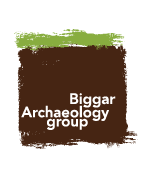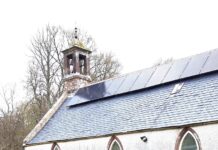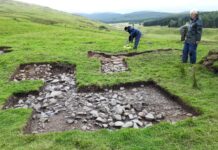
A week in Biggar Archaeology – and what a week
It all began when Tam was asked by a lady in Peebles if he wanted to collect four boxes of flints she had in her possession, they were arrow heads and other tool types. When she mentioned the collector as a Mr Dunlop and that the items were neatly labelled with their dates of discovery, all being in the late 1800’s, Tam immediately knew part of their story. He was on her doorstep within the hour.
The museum already had two boxes of Mr Dunlop’s collection and it is known there were originally over twenty boxes, because he occasionally exhibited them at local events. Furthermore, in the museum archive there is a note book/diary left by Mr Dunlop who worked on local farms, mainly as a drystane dyker. In this fascinating manuscript he tells of the weather and seasons, how much he was paid for certain jobs and the working conditions which prevailed at the turn of the 20th century. He must have developed an eye for spotting stone tools which he collected on his travels round local farms, and meticulously stored them in little glass topped trays (actually sweetie boxes). No attempt was made to describe the items which include leaf, transverse, oblique and barb and tang arrow heads, microliths, scrapers and a range of tools such as knives and other retouched pieces. However, his collecting policy extended to purchasing foreign items as one tray has four large barbed points found in America.

Pleased with the new acquisition for the museum and especially how easy it was come by, Tam took the boxes with him to show the field walkers who turned up over the weekend of 10/11th April. It was pointed out that one arrow in the boxes was a type not yet found by BAG on any of their projects; this was a Late Neolithic oblique arrow, often seen with one side extended further that the other to form a single barb and with a hollow base for hafting.
Work began on Saturday that weekend at the now famous Howburn Farm, near the village of Elsrickle, with two fields which had never been explored. Before lunchtime, one of the group; Brenda Dreghorn had found a flint arrow head – and incredibly it was a perfect oblique one, our first ever and now making No2 in the Biggar collections. Only a few random flint and chert flakes were found after that, but the team were overjoyed at this latest find.

Sunday got off to a good start when Sandra Kelly found another Late Neolithic flint arrow, but this time it was a transverse or ‘duck bill’ type. These arrow types are increasingly being found by BAG on their annual walking and excavation projects. Next major event was a discrete scatter of chert Mesolithic cores and flakes which clearly indicates a camp site. A short time later yet another but larger collection of chert cores and flakes pointed to a second camp site and a tiny microlith helped with its interpretation. The excitement wasn’t yet over for in the last five minutes of work Tam came across another flint arrowhead and unbelievably it was another oblique one! Howburn came up trumps again as an amazing locality for Scottish pre history with three Late Neolithic arrow heads found in one weekend and two Mesolithic sites.

Only a few weeks ago Joyce Durham picked up an exquisite barb and tang arrow at the nearby farm of Biggarshields Mains and Tam followed this up on the same farm (different field) with an equally dainty flint leaf. It seems that BAG are on a roll as far as arrow heads are concerned and there are still many fields left to check out before summer, watch this space.











